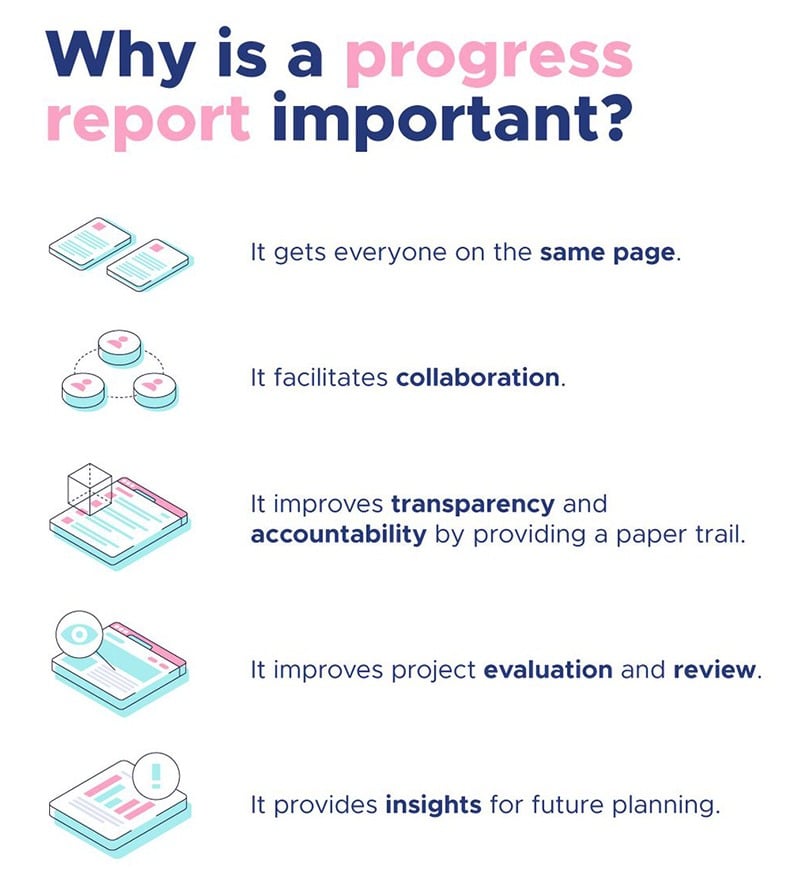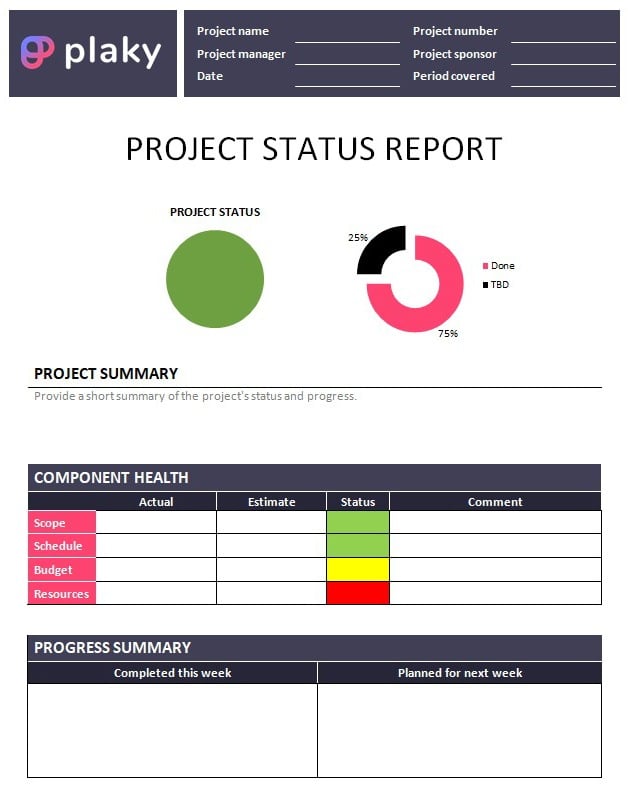

Picture this: You're a project manager juggling multiple tasks, deadlines, and team members. Keeping the balance between different tasks is hard but very important.
Enter the progress report, your secret weapon in conquering chaos and ensuring smooth sailing.
But what exactly is a progress report, and how do you craft one effectively? In this blog post, I'll demystify progress reports and guide you through the process of writing one.
From daily progress reports to weekly progress reports, using practical progress report templates and a tried-and-true format.
A progress report is a vital tool in project management, designed to keep different types of stakeholders informed about the ongoing status of a project.
It's a concise document highlighting current achievements, challenges, and goals, allowing the project manager to track progress and make necessary adjustments.
Project progress reports are one of the most important types of project management reports. They help maintain transparency, communication, and accountability within a team, ensuring everyone is on the same page. They also provide valuable insights for decision-makers, helping them gauge the project's overall health and success.
Here's what you can expect to find in a typical progress report:
Writing a progress report can seem daunting, but it doesn't have to be. You'll create a valuable document that keeps everyone informed and aligned by breaking it down into manageable sections and using clear, concise language.
Embrace the progress report writing skill and watch your team's productivity and communication soar.

Progress reports play a vital role in project management, serving as a communication tool to keep stakeholders updated. Let's delve into why progress reports are crucial for the success of any project or business.
Progress reports eliminate ambiguity and promote transparency. By regularly sharing project updates with stakeholders, the project team is held accountable for their work. This accountability ensures everyone is on track to meet the project milestones and objectives.
Progress reports help identify potential problems before they escalate. Team members can spot bottlenecks, delays, and other issues by examining project data and analyzing the progress report.
Early detection enables the team to take prompt action and prevent these issues from derailing the project.
Armed with accurate and timely information from progress reports, project managers and stakeholders can make informed decisions.
When a project progresses smoothly, management can allocate resources more efficiently or plan for future phases. On the other hand, if a project encounters challenges, swift decisions can be made to reallocate resources or change course.
A progress report's important aspect is maintaining momentum. When team members see their progress documented and shared, it fosters a sense of accomplishment and motivation.
This positive reinforcement encourages teams to keep pushing forward and maintain their productivity.
Progress reports facilitate better communication and collaboration among team members. By sharing updates and insights, the entire team stays informed, reducing the chances of miscommunication or misunderstandings.
Moreover, progress reports provide a platform for team members to ask questions, provide feedback, and offer support.
Business progress reports, such as quarterly, monthly, or annual progress reports, help track performance over time.
By comparing past reports, management can gauge the business's overall health and identify trends or patterns. This historical data can inform future strategies and drive continuous improvement.
The first step in writing a progress report is understanding its purpose. Progress reports inform stakeholders about the project's status, including what has been accomplished, any challenges encountered, and future planning. This allows project managers to keep everyone in the loop and make informed decisions.
The purpose of this monthly progress report is to update the management team on the project's status. It presents an overview of completed tasks, in-progress tasks, upcoming tasks, and any challenges faced during the reporting period. This report will also provide insight into key performance metrics and future planning.
Determine who will read the progress report. Is it for higher-ups, clients, or team members? Tailor the language, tone, and level of detail accordingly.
Decide the reporting period – weekly, monthly, or quarterly. Choose a timeframe that best suits your project's pace and stakeholder expectations.
Gather data on tasks completed, team members involved, and any obstacles faced. Consult previous progress reports, project documentation, and team members for accurate information.
Break down the report into logical sections. Here’s what we suggest:
Craft a concise summary that provides a snapshot of the report. Mention key achievements, challenges, and plans for the future. Keep it brief but informative.
This progress report covers our team's accomplishments during Q1, with a particular focus on the completion of the website redesign and the initiation of our social media marketing campaign. We've encountered some challenges in coordinating with external vendors, but we've implemented solutions to overcome those obstacles.
List all tasks completed during the reporting period. Include the following information:
Outline ongoing tasks, their current status, and expected completion dates. Explain any delays and their impact on the project timeline.
Identify tasks scheduled for the next reporting period. Provide details such as:
Discuss any challenges encountered during the reporting period. Describe how they were resolved or any plans to address them in the future.
Highlight key project management performance indicators and progress toward project goals. Use visuals like charts or graphs to make the data more digestible.
Discuss plans for the next reporting period, including any adjustments required. This may involve reallocating resources, revising timelines, or redefining objectives.
In the next reporting period, our focus will shift to improving user retention and engagement. We plan to implement new features based on user feedback and optimize the onboarding process.
Review the report for clarity, accuracy, and readability. Ensure all information is presented in a clear, concise manner.
Submit the progress report to the relevant stakeholders, ensuring they have ample time to review and provide feedback.
Use this template as a starting point for your progress report:
| Section | Details |
|---|---|
| Project Title | [Project Name] Report |
| Summary | Brief overview of the report's contents, key achievements, and challenges |
| Completed Tasks | Task 1: Description, team members, start and end dates, relevant metrics Task 2: … |
| In-Progress Tasks | Task 1: Description, current status, expected completion date Task 2: … |
| Upcoming Tasks | Task 1: Description, assigned team members, estimated start and end dates, dependencies Task 2: … |
| Challenges | Challenge 1: Description, resolution, or plan to address it Challenge 2: … |
| Key Metrics | Metric 1: Description, current status, target goal Metric 2: … |
| Future Planning | Plans for the next reporting period: any adjustments or changes required |
| Conclusion | Recap of the report's contents: final thoughts or recommendations |
By following these steps and guidelines, you'll be well-equipped to write an effective progress report that keeps stakeholders informed and drives project success. Clear communication is key to maintaining momentum and ensuring everyone is on the same page.

A business progress report helps track company growth, accomplishments, and areas for improvement. It includes:

These reports offer a snapshot of a project or business every three months. They cover:
Monthly progress reports provide more frequent updates on projects or departments. They highlight:

Project status reports focus on a specific project's progress. They showcase:
Personal progress reports help individuals track their growth and development. They include:

When you create a progress report, start by identifying your target audience. Project stakeholders, team members, and future decision-makers should all benefit from your report.
Write in such a way that it is easy for them to understand. Avoid technical jargon and explain industry-specific language so everyone stays on the same page.
Establish a reporting frequency for your progress reports. Whether weekly, bi-weekly, or monthly, maintain consistency. Include report dates and the expected completion date of the current project to provide a clear timeline.
Focus on the project's scope and stay within the project's purpose. Don't digress or include unrelated details. A concise report ensures that readers remain engaged and informed.
Refer to the previous report to identify any changes or developments. Highlight the work completed, project deliverables, and any updates to the project plan. Doing so will maintain continuity and keep stakeholders informed about the department's progress.
Arrange project priorities logically, focusing on the most critical aspects first. Organize the information in a clear, easy-to-follow format. Use headings, subheadings, and bullet points for better readability.
Don't shy away from discussing problems or challenges. Addressing issues helps stakeholders understand the project's status and any hurdles that may affect successful completion. Offer potential solutions or workarounds to demonstrate proactive thinking.
Use relevant data to support your progress. Figures, charts, and percentages can provide a quick overview of the project's status. Make sure your data is accurate, up-to-date, and presented in an easy-to-understand format.
Acknowledge team members who have made significant contributions to the project. This recognition boosts morale and encourages continued excellence.
Discuss what's next for the project, such as upcoming tasks or milestones. This helps stakeholders understand the trajectory of the project and anticipate the work ahead.
Present complex ideas in a simple, easy-to-understand language. Break down complicated concepts into manageable chunks. Offer actionable insights and practical takeaways, so stakeholders can quickly grasp the project details.
Create a database to store all progress reports. This repository helps stakeholders access past reports and provides valuable insights for future projects. It also ensures that information is preserved and easily accessible when needed.
Before sharing your progress report, proofread and edit for clarity, consistency, and accuracy. This step ensures that your report is polished, professional, and easy to understand.
A progress report is most valuable when you're working on a long-term project. It's a way to keep stakeholders updated on progress and share important insights.
What is the main purpose of a progress report?The primary purpose of a progress report is to provide a clear and concise overview of a project's status. This includes:
– Communicating progress toward goals
– Identifying potential issues and solutions
– Demonstrating accountability and commitment to the project
– Providing a step-by-step guide of completed tasks and upcoming work
– Offering visual aids, like charts and graphs, to illustrate data
A well-crafted progress report keeps stakeholders informed and fosters collaboration. It's also valuable for maintaining momentum and motivation throughout the project.
So, you've reached the end of this blog post. You're now equipped with the knowledge and tools to make progress report writing a breeze. Remember, it doesn't have to be a daunting task.
Keep it simple, stick to the facts, and let your progress shine. Talk about what you achieved, any challenges you faced, and how you overcame them. Use a clear, concise, structured format to ensure your message is easily understood.
To simplify the process, check out our guide on project reporting tools.
Considering these questions will make your progress report informative, actionable, and engaging. And don't forget, practice makes perfect. The more progress reports you write, the easier and more efficient the process will become.